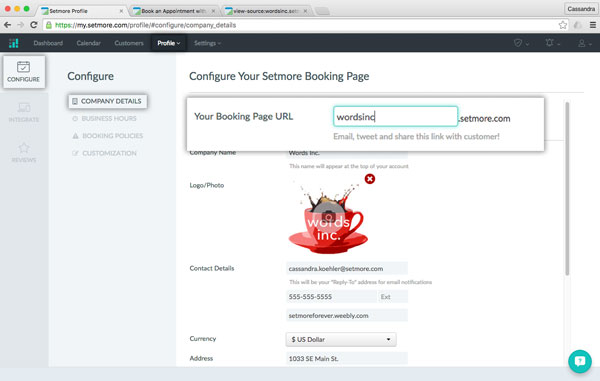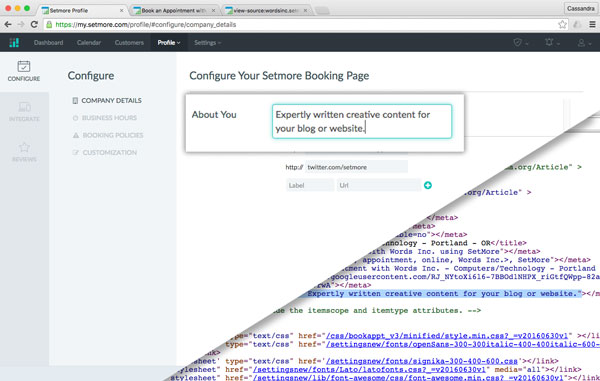Why simplify is your new strategy: How to build your business in one space
Many small service-based businesses start with one goal: to help people. But over time, the behind-the-scenes demands start to stack…

I can’t stop writing about Setmore’s booking page. It’s the bread and butter of what we do, it’s where new customers come to book their first online appointment and returning customers book their next appointment. It’s where most of the action happens. So the question that’s been on my mind lately is, how do you make your booking page work even better?
This post is all about fine-tuning your Setmore booking page. The goal is to encourage best customer behaviors, namely the sharing of your booking page as well as making it easier to find via Google searches. New users will learn a lot, and Setmore veterans just might pick up a thing or two. So without further ado, let’s get started.
First thing’s first: shorten your booking page URL to something memorable. You can do this in your Setmore account by going to Profile > Configure > Company Details. Under the section where it says “Your Booking Page URL,” click the “Edit URL” button, then enter your new URL and click outside the form field to save your changes.

Here’s how you get a custom .setmore URL in seconds.
Some advice to heed when you’re customizing your booking page URL – phrases are easier to remember than long company names with funky spellings. So if your business name is already taken or the name is difficult to remember, then use one of these handy formulas for a viable alternative:
Your city’s name + what your business does.
Ex: pdxhaircuts.setmore.com
A cool-sounding adjective + what your business does.
Ex: suavecuts.setmore.com
Your brand’s tagline or slogan.
Ex. looksharp.setmore.com
The goal is to contribute greater specificity to your URL and therefore make it more relevant to your audience, while still keeping it easy to remember.
There’s a couple of things you can do to help ensure that your booking page is indexed by Google and other search engines. The first is to fill out the company details for your booking page (which you can do by going to Company Details menu we mentioned in Step #1). Setmore uses this information to populate the metadata on your booking page.
 Your company details are used to fill in your booking page metadata.
Your company details are used to fill in your booking page metadata.
For those who don’t know, metadata isn’t visible to your online customers, but it’s what Google looks at to determine keyword relevancy and page ranking on search results. Pay specific attention to the “Logo/Photo” and “About You” sections, which populate the meta image and meta description tags respectively. These will come into play later on – I’ll show you where.
Psst… wanna know another easy way to accelerate the indexing process? Add the booking page URL to your website and Facebook page. Why does this work? Because when Google gathers data for its rankings, it looks at existing pages first and then combs for new pages.
Adding your booking page URL to your email signature is a nice touch. People who you email frequently will now have your booking page handy in their inbox, which is great in case they want to give a referral. Most email clients allow you to embed and hyperlink images with in your signature as well. However, I’d recommend sticking with plain text, as you’ll avoid browser incompatibility issues or spam filters, and you’ll encourage recipients to memorize the URL mnemonically.
Here’s a quick rundown of how to add your booking page URL to your email signature in Gmail.
 I’d also recommend putting the link in red font to make it stand out.
I’d also recommend putting the link in red font to make it stand out.
Wi-Fi and smartphones are everywhere and yet business cards are still going strong. One could argue it’s the aesthetic of it… sharing your LinkedIn just isn’t as suave as sliding a crisp card (bone-white with raised type) across the table. So until the unforeseeable future when business cards become obsolete, they will still serve as a suitable place to advertise your booking page. The merits of this method rely solely on having a short and sweet URL (again which is why we put that as our #1 on this list).
 LinkedIn profiles: definitely not as hip as business cards.
LinkedIn profiles: definitely not as hip as business cards.
I don’t need to tell you that your booking page URL should be on your Facebook profile, or in the About section of your Instagram, YouTube, and Twitter accounts. The real benefit of social media is the act of sharing, reposting and retweeting. And the thing that some businesses may have overlooked is that nobody can share your social account’s profile section.
You need to actively post your booking page URL to make it shareable, and you need to post it on the regular to make it effective. Whenever you post your booking page, make sure you mix it up by adding a new image, or doing something to give the post a sense of purpose and avoid the impression of spamming your followers. Advertising last-minute openings is always good reason for doing so.
Also noteworthy: when you post a link to Facebook or Twitter, these platforms will usually pull content from the link’s metadata to create a preview (this is what we were talking about at the tail end of #2, above). So the image that you provide for your logo and your “About You” description will be reproduced here.
 This works on Facebook, LinkedIn and Twitter, among other platforms.
This works on Facebook, LinkedIn and Twitter, among other platforms.
I know you’re busy so here’s some more good news: each of these only takes about five minutes to put into action, and all of them working together can offer a multiplicative value to your business. You’re building an environment that encourages success, and having more avenues to book an appointment or share referrals to your booking page means a greater likelihood of more appointments in the long run.
Thanks!
-The Setmore Team
What are some of your preferred methods for promoting your booking page? Let us know in the comments below!

by Cassandra
Writer, editor and scheduling product expert at Setmore Appointments.

